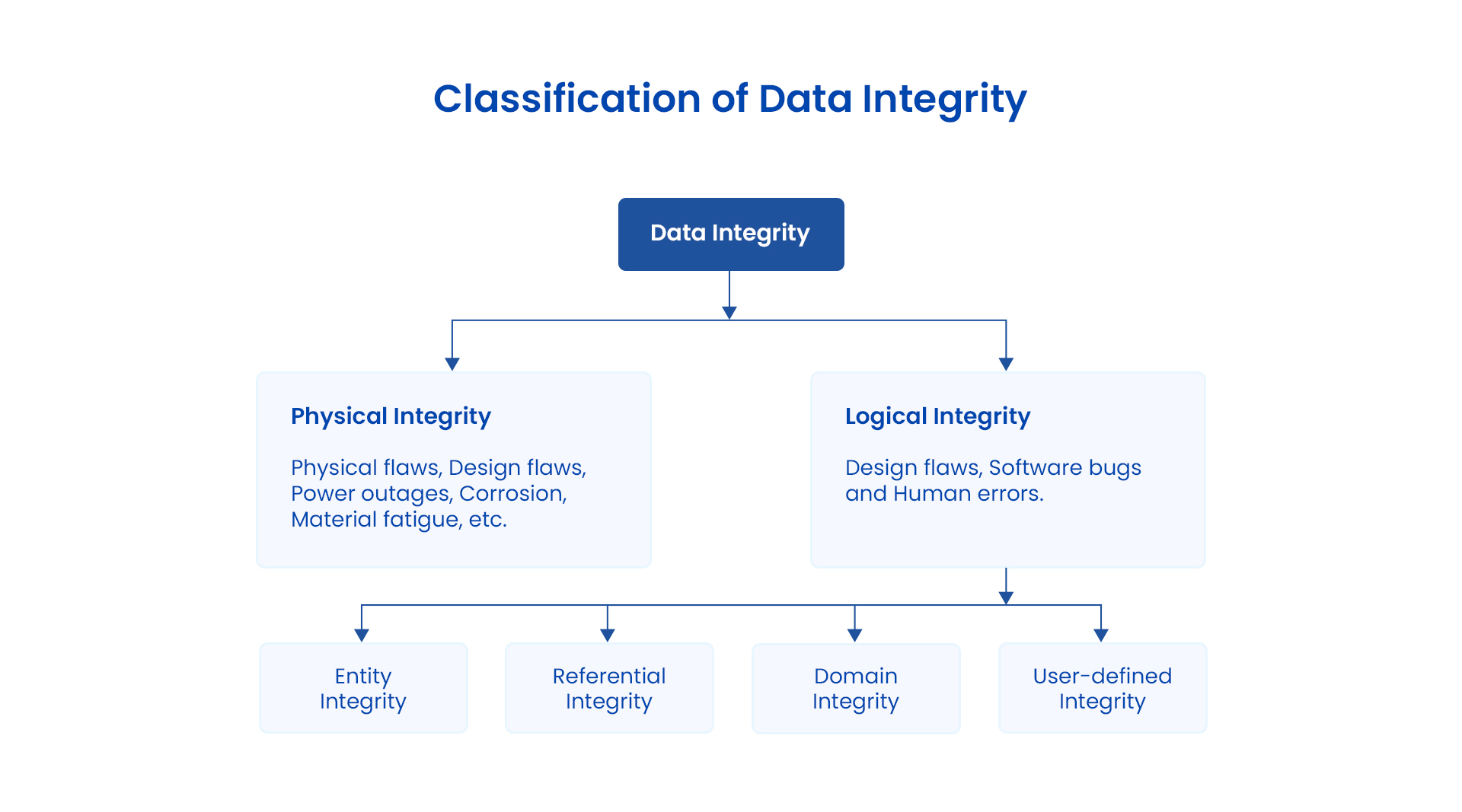What Is Data Integrity?
Data integrity is a process of maintaining the accuracy, consistency, and reliability of data throughout its lifecycle. It ensures that data is not altered or corrupted during storage, transfer, or processing.
By maintaining data integrity in DBMS, organizations ensure that the information they work with is complete and trustworthy. This is important because accurate data is essential for making informed decisions, analyzing data trends, and preventing errors.
In simple terms, data integrity guarantees that the data remains unchanged and reliable, helping businesses to work with the correct information. Without data integrity, the quality and trustworthiness of data would be compromised.
Types Of Data Integrity?
Organizations can protect their data by using various types of data integrity constraints, these integrity constraints are rules that control actions like deleting, adding, or updating data. These rules help to ensure data integrity in both hierarchical and relational databases, like those used in enterprise resource planning (ERP), customer relationship management (CRM), and supply chain management (SCM) systems.
Data integrity can be maintained in two main ways: Physical Integrity and Logical Integrity are these two important ways to protect data and keep it accurate. Let us explain both in detail to understand this concept better:

1. Physical Data Integrity
Physical integrity focuses on protecting the accuracy and completeness of data when it is stored or retrieved. It deals with ensuring that data remains correct, even when there are physical issues or external factors that could harm it.
To protect physical data integrity, organizations use methods like backup systems, error correction codes, and security measures that help in recovering or restoring of data if something goes wrong.
2. Logical Data Integrity
Logical integrity focuses on keeping data correct and unchanged as it is used and manipulated within a database. This type of integrity ensures that data remains consistent, regardless of how it is accessed or processed by users or applications.
Logical integrity is maintained using specific rules and constraints, which ensure that data follows certain patterns and stays consistent throughout the system. Here are the four main types of logical data integrity:
- Entity Integrity: It ensures that each piece of data is unique and identifiable. This is done by using primary keys in databases, which help to ensure that no duplicates and no missing information is there in the data.
- Referential Integrity: It ensures that data relationships are maintained properly. For example, if a particular record is deleted, all the related records are handled properly to avoid broken links or errors.
- Domain Integrity: This ensures that data entered into a database system follows specific rules. These rules include things like making sure the data type (e.g., numbers, text, dates) is correct and that data fits within a defined range.
- User-Defined Integrity: Allows users to set custom rules for data, based on their specific demands and requirements. This helps organizations to ensure that their data is protected in ways that are unique to their operations.
Why Is Data Integrity Important?
In today’s data-driven world, maintaining data integrity is crucial for organizations to make informed decisions based on accurate and reliable information. When integrity is ensured, businesses can trust that the data they are using for planning, analysis, and operations is correct and consistent. Let us look at some of the factors below defining why is data integrity important:
- Accurate Decision-Making – Integrity ensures that data is correct, consistent, and reliable. This allows organizations to make decisions based on facts rather than flawed or incomplete information. Accurate data leads to better business analytics and outcomes.
- Improved Efficiency – When data is reliable, processes across the organization run more smoothly. Accurate data reduces the time spent on re-checking information or fixing errors, which saves time and efforts of the individual in Data Handling.
- Increased Trust and Credibility – Maintaining data integrity builds trust within the organization. When people can trust the data, they feel more confident in the systems and processes used by the organization.
- Compliance with Regulations – Many industries have strict data regulations, such as healthcare, finance, and legal sectors. By following data integrity, it helps organizations to comply with data security laws and regulations.
- Protection Against Data Loss and Corruption – Data integrity protects the data against accidental loss, corruption, or manipulation. This includes protections from issues like hardware failure, cyber-attacks, or human error, ensuring that data remains intact and accessible when needed.
- Enhanced Security – This includes protecting data from unauthorized changes, and ensuring that only authorized users can modify or access information. Data Integrity In DBMS helps in preventing security breaches or data tampering, which could lead to fraud or misinformation.
Data Integrity Vs Data Quality
Most people often get confused between data integrity and data quality, thinking they are the same terms. However, in reality, they are different concepts. While both are crucial for maintaining useful and reliable data, they focus on different aspects of data management. Data integrity ensures that data is accurate, consistent, and secure throughout its lifecycle.
On the other hand, data quality is about how useful, complete, and relevant the data is for a specific purpose. Let us understand the difference between these two terms with the help of the table below:
| Data Integrity Vs Data Quality | |
| Data Integrity | Data Quality |
| It ensures the accuracy, consistency, and security of data throughout its lifecycle. | Data Quality measures how useful, complete, and relevant the data is for a specific purpose. |
| Integrity protects the structure and correctness of data. | Data Quality focuses on whether the data is usable, up-to-date, and fits the business needs. |
| Integrity’s main goal is to ensure that data remains unchanged during processing, storage, and retrieval. | It ensures that data is of high value and meets the desired standards for use. |
| Data Integrity Examples include- Preventing data loss, maintaining reliable data, and enforcing rules like primary keys and foreign keys. | Data Quality example is like- Ensuring customer contact details are accurate and up-to-date for communication. |
| It is maintained through integrity constraints like entity, referential, and domain integrity. | Data Quality is achieved through data governance, quality checks, and continuous data monitoring. |
How To Ensure Data Integrity?
Data integrity is essential for businesses to protect their information from various risks and ensure accuracy and reliability. Let us look at the step-by-step process of how data integrity is attained within an organization.
Step-1. Define Data Integrity Policies- The first step in ensuring data integrity is creating clear policies and guidelines that defines how data should be managed and protected. These policies involve defining:
- Rules for data entry, storage, and retrieval
- Access control policies to limit who can edit or delete data
- Guidelines for data backup, recovery, and validation
Step-2. Implement Data Validation Techniques- Data validation ensures that only correct and accurate data enters the system. Implementing these techniques involve:
- Setting validation rules that check for correct formats.
- Ensuring required fields are filled out properly
- Limiting data input to acceptable ranges (e.g., size, quantity limits)
Step-3. Use Integrity Constraints- Integrity constraints are set of rules within databases to enforce data integrity, we have discussed these integrity constraints above, explaining what each constraints have. Using these constraints ensures that the data stays accurate, consistent, and reliable across all systems.
Step-4 Ensure Data Security and Access Control- Data security is a key to protecting integrity. This involves:
- Limiting access to sensitive data based on user roles
- Using encryption to protect data from unauthorized access or modification
- Implementing audit trails to monitor who is accessing or editing data
Step-5. Regular Data Audits and Monitoring- Conducting regular data audits helps to identify potential errors or inconsistencies in the system. This process includes:
- Reviewing databases for duplicates, incomplete records, or inaccurate entries
- Checking for compliance with data integrity policies
- Ensuring backups and recovery plans are in place
Auditing and monitoring enable organizations to quickly spot and resolve issues, ensuring data remains accurate and secure.
Step-6. Backup and Recovery Systems
Having backup and recovery systems in place is critical for maintaining data integrity in the event of system failures or data loss. This includes:
- Creating regular backups of important data
- Storing backups in secure, off-site locations
Having a disaster recovery plan to quickly restore data if it is lost or corrupted ensures that data can be restored without loss of integrity, even after unexpected incidents. By following these steps, organizations can effectively achieve and maintain data integrity, minimizing risks and maximizing the value of their data.
Learn Data Analytics With PW Skills
Join the Comprehensive Data Analytics course offered by PW Skills and learn everything you need to excel in this exciting field of Data Analytics.
This course is specially designed by experts considering all the in-demand tools and skills required to excel in this career. Enrolling in this course will provide you with benefits like- regular doubt-clearing sessions, daily practice sheets, access to PW labs, mentorship from expert industrialists, 100% placement assistance, resume review sessions, and much more.
Don’t let this chance slip away. Visit PW Skills today and take the first step towards a rewarding career in data analysis.
Data Integrity FAQs
Why is Data Integrity Important?
Data integrity is crucial because it ensures the accuracy and reliability of data used in business operations and decision-making. Without it, organizations risk making decisions based on incorrect or corrupted data, which can lead to financial loss, legal issues, and damaged reputations.
What are the Types of Data Integrity?
The two main types of data integrity are Physical Data Integrity, which protects data from physical harm (e.g., hardware failures), and Logical Data Integrity, which ensures data consistency and accuracy within databases through rules and constraints.
How Do You Ensure Data Integrity?
Data integrity can be ensured by implementing security measures, using integrity constraints (like primary and foreign keys), regular data validation, backing up data, and conducting regular audits to identify and correct any errors or inconsistencies.
How is Data Integrity Different from Data Quality?
While data integrity focuses on ensuring data remains accurate, consistent, and reliable over time, data quality refers to the overall condition of data, including factors like completeness, accuracy, and relevance. Data integrity is essential to maintaining high data quality.

